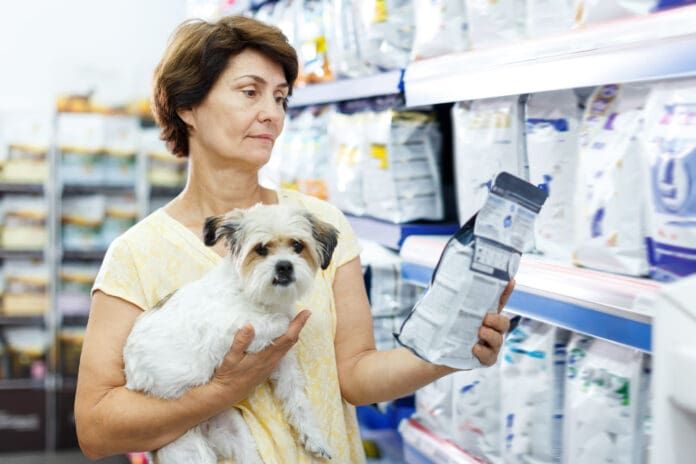Finding a suitable food for dogs with dietary sensitivities, allergies, or chronic digestive issues can be a challenge, and often veterinarians suggest foods that contain hydrolyzed proteins as a solution. By feeding a hydrolyzed diet, you can ensure your dog is getting complete and balanced nutrition while you methodically isolate and identify dietary triggers. So, what is hydrolyzed protein, why is it used, and are there any side effects to be concerned about when feeding it to your dog?
Protein Problems
When dogs have sensitivities or reactions to food, proteins are often the cause (chicken is the most common protein in dog foods). Proteins are large, complex molecules, with unique shapes and characteristics. Sometimes, the immune system can mistake these proteins as a threat and attack them, causing an inflammatory, or immune, response that can leave dogs feeling itchy, lethargic, and sick.
However, the process of hydrolyzation uses enzymes to break proteins down into smaller, more easily digestible pieces, such as amino acids and peptides. These smaller pieces are less likely to trigger an immune response in the body, making hydrolyzed-protein food an ideal choice for dogs with food sensitivities or allergies.
Hydrolyzed Proteins Are Nutritious
Despite being broken down into smaller pieces, hydrolyzed proteins retain their nutritional value. When dogs eat protein, their bodies break down the proteins into individual amino acids that can then be used to repair cells, build muscles, create enzymes, and more. But with hydrolyzed proteins, the hard work of digesting the protein down into those smaller components has already been done, making these proteins more bioavailable than intact proteins.
Side Effects of Hydrolyzed Protein Dog Food
While there are many benefits to feeding diets that contain hydrolyzed protein, there are some downsides to them as well:
- Price: Hydrolyzed proteins are more expensive than traditional proteins due to the specialized processing they must undergo. This added cost makes the resulting food expensive, especially for large breeds who need to eat large quantities of food, or for dogs who need to be on these specialized diets long-term.
- Palatability: While intact proteins tend to be tasty, amino acids can be bitter, making some hydrolyzed foods less tasty than traditional diets. Because of this, pickier dogs may not be willing to consume hydrolyzed diets.
- GI Upset: While hydrolyzed proteins are generally easier to digest, some dogs may experience gastrointestinal upset during the transition period onto the new diet. Temporary diarrhea, vomiting, and flatulence may occur as your dog’s digestive system adjusts to the new food.
Diets using hydrolyzed proteins can be a valuable solution for dogs with food sensitivities, allergies, or digestive issues. Hydrolyzed diets can offer benefits such as reduced allergenicity and improved digestibility, while still providing your dog with complete and balanced nutrition. Of course, cost considerations and a dog’s willingness to eat the diet due to palatability concerns are factors that need to be weighed when choosing a hydrolyzed diet for your pet. As always, consult your veterinarian if your dog requires specialized dietary support.







Thx for this article. My rescue girl came to me with a lot of digestive issues and the hydrolyzed kibble (that is flavored to be like chicken) plus the fish and other whole foods I give her has kept her healthy.
The problem is that most dogs displaying symptoms aren’t really allergic to things in their diet. If the total population of dogs with “allergies,” only 15% are actually allergic to diet sources. Yet, vets always start with these overpriced, unpalatable prescription diets.
My rescue developed severe gastroenteritis a few months after I got her. She had many special tests from Texas A&M’s GI Lab and a number of meds. Some of the common anti-diarrhea meds and supplements didn’t help. What helped was Royal Canin’s HP (hydrolyzed protein) mixed with Just Food for Dogs fish and potato food. The terrible bloody diarrhea she had resolved; I’ve gradually added in other foods with no problems. I’m grateful for these foods that allowed her to keep a good condition right away instead of drawn-out food trials.
My Great Dane is eating The HF Royal Canin. He loves it and he poops a lot less.
I feed a hydrolyzed protein diet to my Gordon Setter who suffered from Irritable Bowel Disease. The product has really helped with this issue and he is symptom free. My problem is that because these diets are only average calorie count. I cannot get enough calories into my dog daily to have him maintain or gain weight. I worry that his energy level is low because he is not receiving enough calories per meal. After feeding 3 meals per day for several days, he is so “full” that he starts skipping meals/not eating. That drops his calorie intake.
I am trying a dietary trial by adding a unique protein source topper.
I would have thought that feeding a high carbohydrate food to a dog already dealing with high inflammatory issues could in any way help?
While the author explains what hydrolyzed protein (kibble?) is, she fails to provide detailed information on the actual process of how that happens. HHP and extrusion of rendered meat products in typical kibble changes the chemical nature, making it highly questionable. What is the chemical, mechanical or otherwise process in which “hydrolyzed protein” is made?
I guess I am surprised that this is considered a good long term food for dogs. After ALL the concern about processed kibble and what it’s doing to our dog’s long term health and the need for a “real food” based diet, how can this be considered a good choice?